The fact that the road was handed over on 31 August 1896 did not mean that it would not have been possible to drive on the Outer Ring Road until then, only that the Public Works Council had carried out the work entrusted to it, the boulevard had been built along its entire length and width.
One of the largest works of the Budapest Public Works Council, founded in 1870, was the Outer Ring Road. The route in Pest from Margit Bridge to Boráros Square was built over 25 years and became a defining feature of Pest's spatial structure. Its plans date from 1868-1869 when it was suggested that an elegant boulevard would be needed within the built-up area of Pest. The prime minister, Gyula Andrássy, was the biggest supporter of the idea.
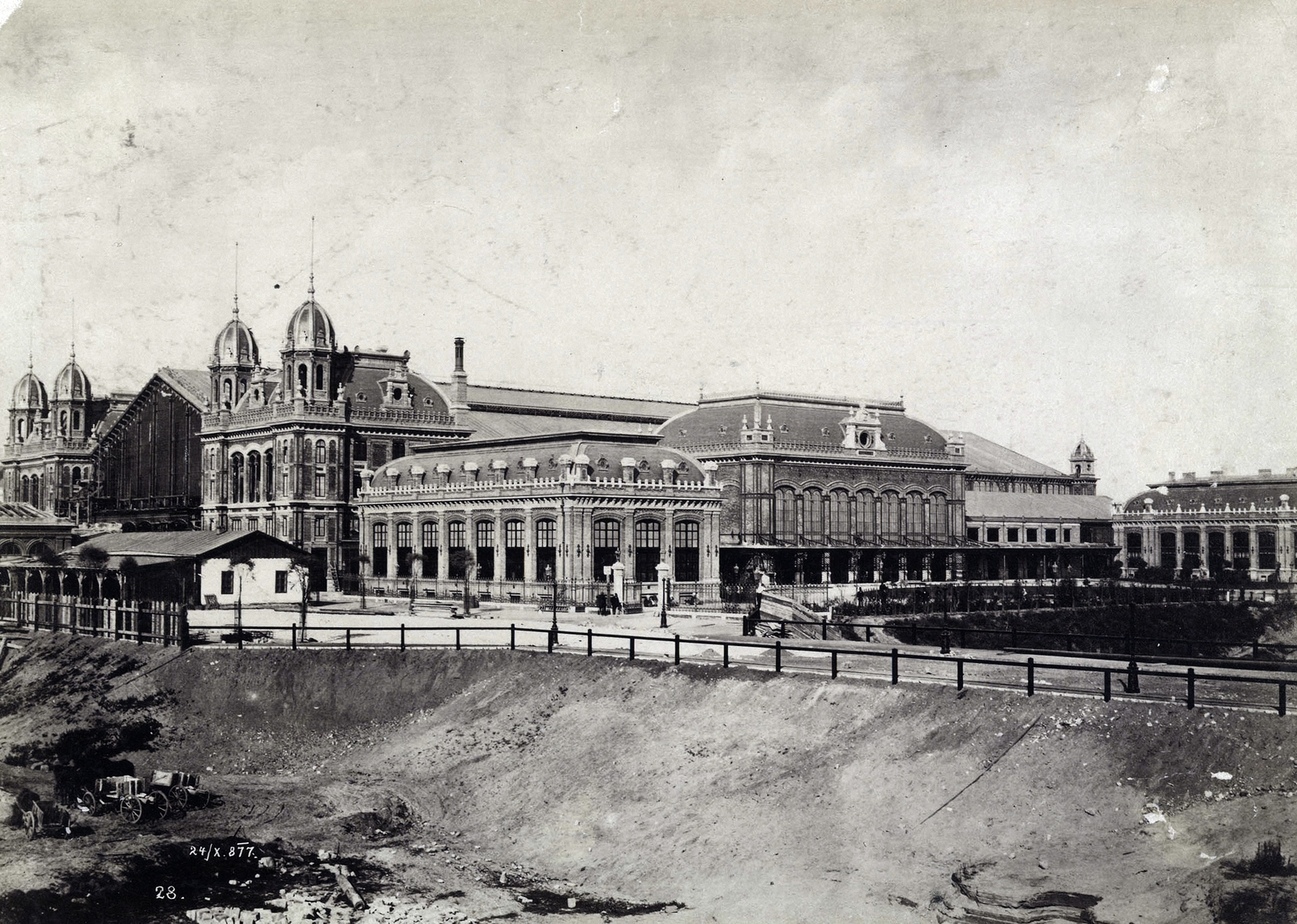 Construction of Teréz Boulevard in 1877, photo by György Klösz. The station stood on an embankment above the ground level, protected from flooding (Photo: Fortepan/Budapest Archives, No.: HU.BFL.XV.19.d.1.05.201)
Construction of Teréz Boulevard in 1877, photo by György Klösz. The station stood on an embankment above the ground level, protected from flooding (Photo: Fortepan/Budapest Archives, No.: HU.BFL.XV.19.d.1.05.201)
Of course, there were opponents of the Outer Ring Road. It was raised in the Parliament that it is not a national issue, why should the country's money be used for this? It is a matter for Pest which, as some MPs noted, was not even asked about it. In the debate, the government naturally argued that the construction of such a road was a national priority. This is a nationwide task, as it is beyond the capabilities of Pest, and it is precisely for such tasks that the Budapest Public Works Council was set up. In 1871, the Parliament finally granted the requested amount of 900 000 forints, which was only enough to start the works.
The task of the Public Works Council, established for the development of Budapest, which did not officially exist at that time (the capital was established only in 1873), was to clean the route and secure the place, because only parts of the planned line of the Outer Ring Road, today’s Szent István Boulevard was empty. Elsewhere, there were many buildings, factories and one-storey houses, as it was still a suburb of Pest at that time. The Public Works Council had expected the Outer Ring Road to close the city centre, thus allowing investors to build more urban buildings in and around the boulevard. The new road, then known as the Outer Ring Road, was also important from a transport point of view as it was intended to connect the boulevards leading to Pest and the suburbs.
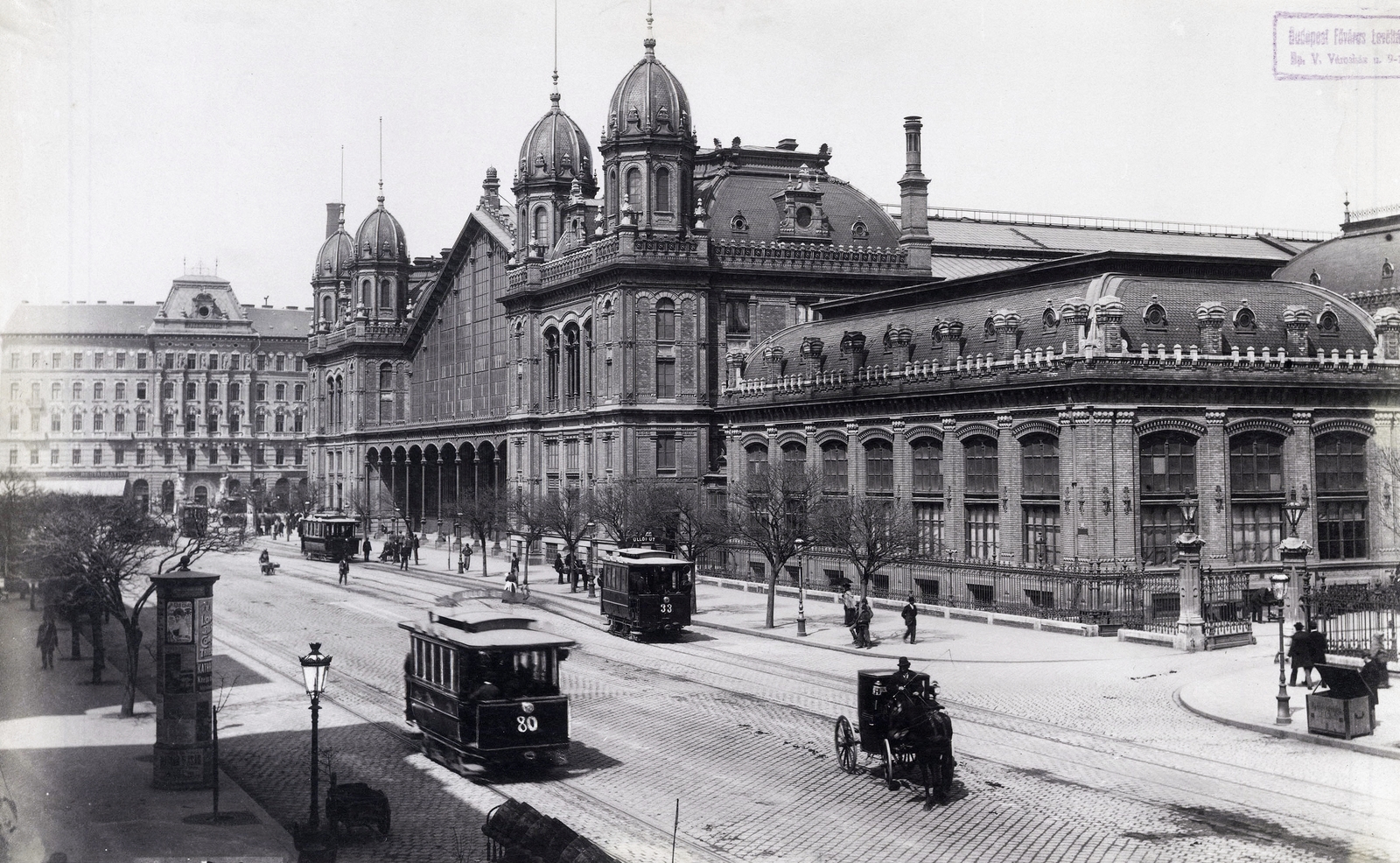 Only 13 years later, trams were already ringing in the same place (Photo: Fortepan/Budapest Archives, No.: HU.BFL.XV.19.d.1.07.138)
Only 13 years later, trams were already ringing in the same place (Photo: Fortepan/Budapest Archives, No.: HU.BFL.XV.19.d.1.07.138)
As Pestbuda has written, the road was not empty, it was mostly built-in between Király and Üllői Road, where the largest proportion of houses had to be demolished. However, in the way of the boulevard, there were not only smaller and larger houses but also several huge buildings, such as the predecessor of the Nyugati Railway Station, the station building of the Hungarian Central Railway, which ran to the line of today's Jókai Street.
Negotiations between Pest, the Public Works Council and the owner of the railway station, the Austrian State Railway Company, began almost immediately on how this problem could be eliminated. As a solution, the railway company built a new, larger, more modern station. It became the Nyugati Railway Station, designed by August W. De Serres and built by the Eiffel Company, which opened in 1877 and whose elegant facade has already been aligned with the Outer Ring Road. As the old hall was demolished and the new hall was established further north, the office building recently added to the old train station was moved to the other side of the boulevard and stood until 1978.
For a long time, MÁV, Pest and the Public Works Council also tried to establish the new central railway station planned to be built here, on the line of the Grand Boulevard. They also looked out for its place, the area of today's Népszínház Street, but it would have been so expensive to run the railway lines there that they eventually gave up on it and the Keleti Railway Station was built farther from the city.
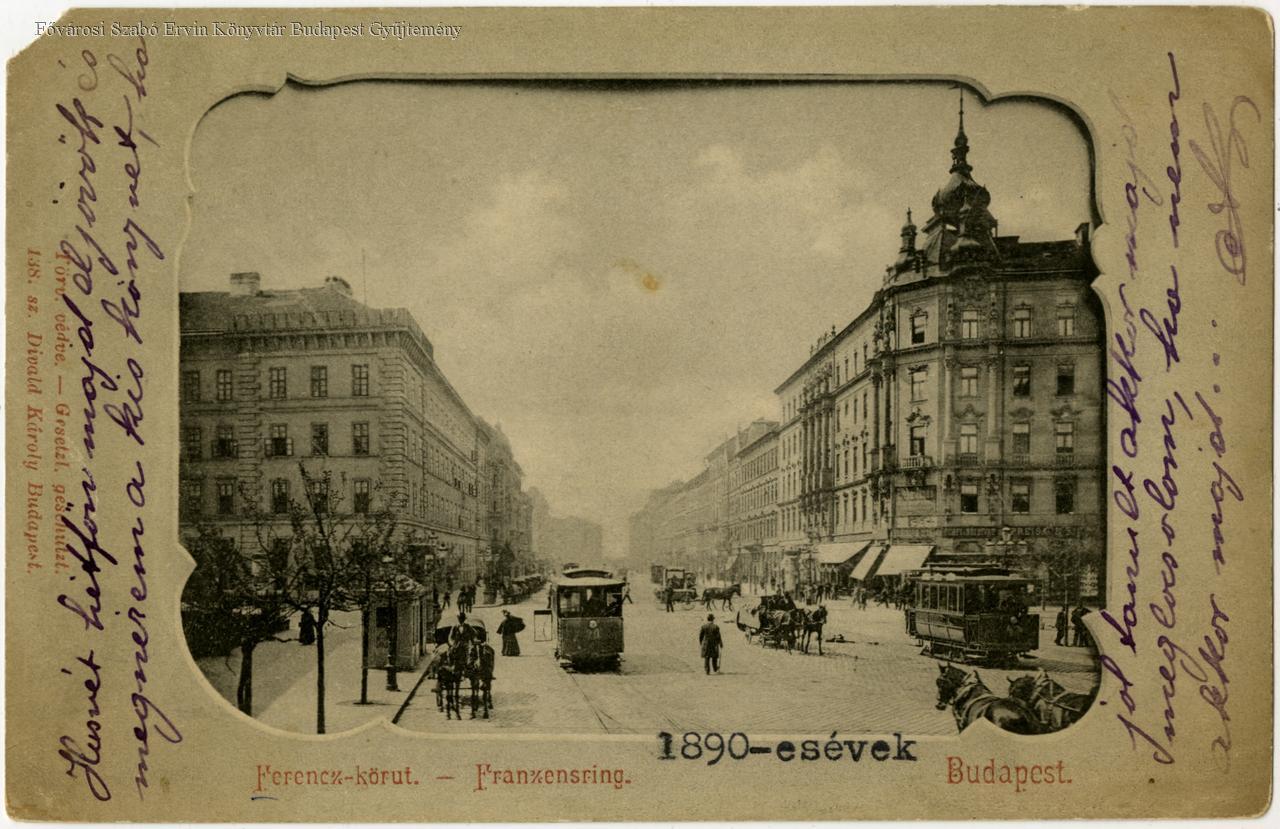 Outer Ring Road on a postcard from around 1900, based on a photo by Károly Divald. To the left, is the oldest building on the boulevard, Maria Theresa, later known as the Kilián Barracks. The domed building on the other side of the road is 46 Ferenc körút, which is the site of today's lottery house, which was demolished after the 1956 revolution. (Photo: FSZEK Budapest Collection)
Outer Ring Road on a postcard from around 1900, based on a photo by Károly Divald. To the left, is the oldest building on the boulevard, Maria Theresa, later known as the Kilián Barracks. The domed building on the other side of the road is 46 Ferenc körút, which is the site of today's lottery house, which was demolished after the 1956 revolution. (Photo: FSZEK Budapest Collection)
However, there was a building that could not be demolished, this was Maria Theresa, later called Kilián Barracks, built in 1845 according to the plans of József Hild, so the route of the boulevard was adapted accordingly. The huge house still stands on the corner of Üllői Road and Ferenc Boulevard.
The Public Works Council only received money and authorisation for the necessary expropriations, the liberation of the area, not for construction, which was expected from private investors. But as soon as construction could have begun, the stock market crash of 1873 struck, slowing investment for years. At the same time, the expropriations were slow as well, so in 1877 only certain sections of the road could be opened.
Expropriations continued even in the 1880s, and it was not until 1888 that the entire work area came into the possession of the Public Works Council. This did not mean that the road was completed, as at that time it was only possible to travel from Margit Bridge to Üllői Road and a part of Ferenc Boulevard.
Larger constructions could have started in the 1880s, the significant buildings of the Outer Ring Road were completed by the 1890s. On the Szent István Boulevard - which until 1937 was called Lipót Boulevard - the building of the Vígszínház could only be built in 1895 after the section of the road was completed. The theatre was designed by Ferdinand Fellner and Hermann Helmer, who at this time designed a total of 47 theatres worldwide, specifically to meet the needs of urban citizenship. The eye-catching building was finished in just one year, on 1 May 1896, despite the fact that the area was still largely swampy at the time.
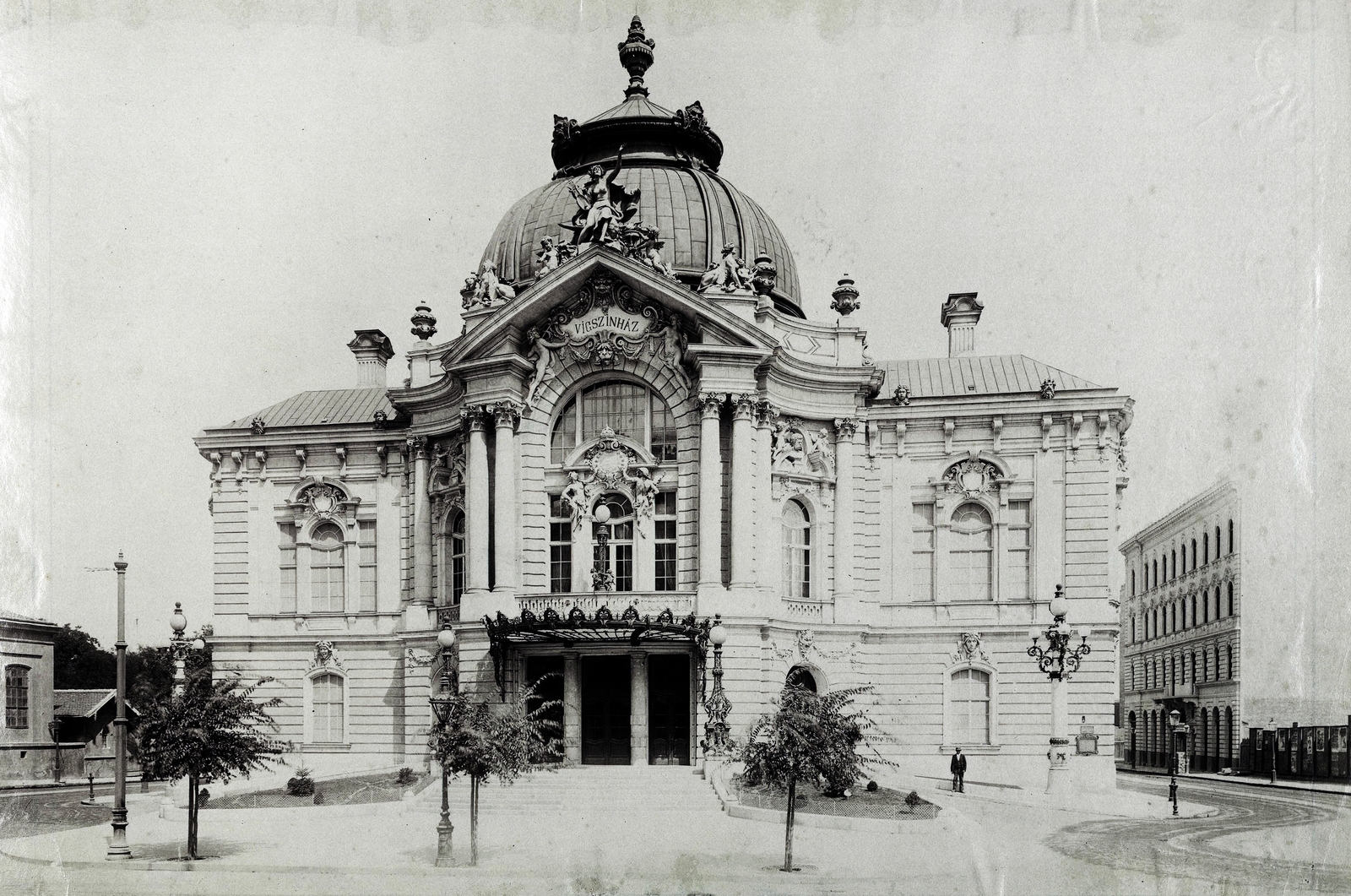 Vígszínház, in the year of its opening, photo by György Klösz. The one-storey houses in the area are still visible on the sides. (Fortepan/Budapest Archives, No.: HU.BFL.XV.19.d.1.08.108)
Vígszínház, in the year of its opening, photo by György Klösz. The one-storey houses in the area are still visible on the sides. (Fortepan/Budapest Archives, No.: HU.BFL.XV.19.d.1.08.108)
The situation is well reflected in the Uj Idők's note on the Vígszínház and the Outer Ring Road on 29 March 1896:
"On the first of May, Vígszínház will be opened with the prologue of Andor Kozma and the comedy of Mór Jókai. Its magnificent baroque building on Lipót Boulevard is ready and the only ornament of our bleak boulevard.”
Walking along the boulevard, a lot of interesting houses can be seen. For example, there is the house at 13 Teréz Boulevard, near Oktogon. Built in 1885, the facade is based on Palazzo Strozzi in Florence. True, the Budapest one is smaller and the entrance is not in the middle, but on the edge of the house, but the design and many details are similar, including iron rings for mooring horses, St. Mark's carvings in the windows and other ornaments. The palace was built by Count Géza Batthyány and designed by Alajos Hauszmann. By the way, it was the only noble palace on the Outer Ring Road, as it was more the residence of the bourgeoisie.
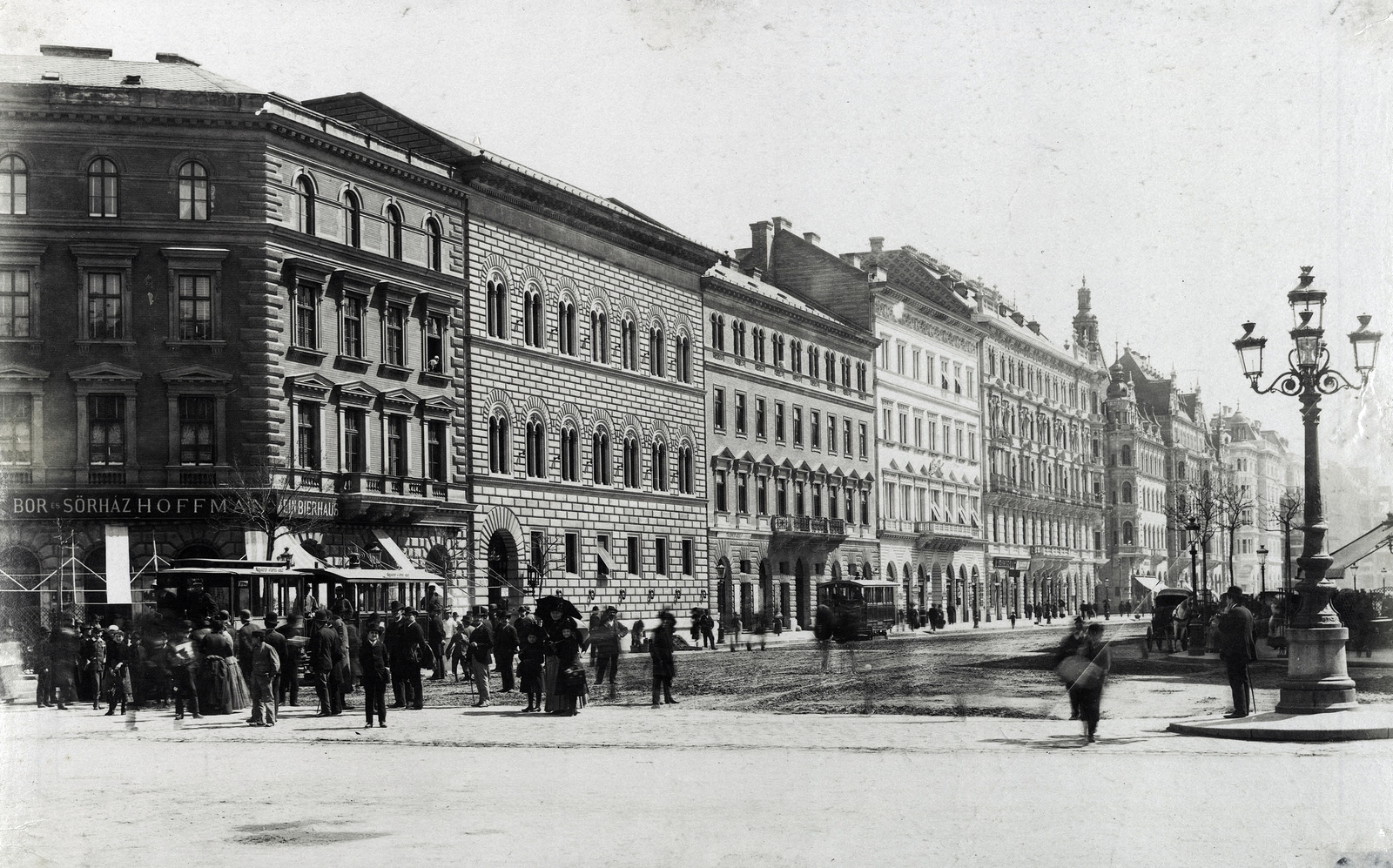 The Oktogon. In the background is the Batthyány Palace, which evokes the facade of Palazzo Strozzi in Florence (Photo: Fortepan/Budapest Archives, No.: HU.BFL.XV.19.d.1.08.032)
The Oktogon. In the background is the Batthyány Palace, which evokes the facade of Palazzo Strozzi in Florence (Photo: Fortepan/Budapest Archives, No.: HU.BFL.XV.19.d.1.08.032)
The New York Palace, opened in 1894, is home to the New York Café, which occupies a prominent place in Hungarian literary life. The office building was erected by the New York Life Insurance Company, hence the name New York Palace, and Alajos Hauszmann, Flóris Korb and Kálmán Giergl were asked to design it.
Next to the Outer Ring Road, at EMKE, on today's Blaha Lujza Square, stood the Népszínház, which was handed over in 1875, i.e. the later National Theatre, which was also designed by the architects Fellner and Helmer. Although the building stood with its back to the boulevard, everyone knew where to meet if they were waiting for "at the National Theatre, where tram 6 stops."
Tram 6 is inseparable from the Outer Ring Road and is now one of the busiest tram lines in the world. As the Outer Ring Road was built, so was the tram. The first test tram was started in 1887, but in the 1890s tram lines were built on the entire Outer Ring Road. Until 1890, the carriages ran between the Nyugati and today's Blaha Lujza Square, and in 1892 to the Boráros Square. The number 6 was given to the Outer Ring Road line in 1910 when the numbering of lines was introduced in Budapest.
The Outer Ring Road had another role, perhaps as important as its transport role. This also served Budapest, which wanted to become a big city, but it was not spectacular at all, but its effect was noticeable, as one of the most important main collecting canals runs under the Outer Ring Road, which drains the sewage of the city districts. Its construction was extremely important in the great epidemics of the age, especially in the fight against cholera.
Although the Outer Ring Road is a boulevard only in its Hungarian name (Nagykörút), it consists of straight sections. There is no curve in the road itself, the trail breaks only at the intersections, it slopes slowly from Nyugati to Boráros Square, follows the line of the main canal, only a small ascent breaks it. At the intersection of Oktogon, Teréz Boulevard and Andrássy Road, the Outer Ring Road rises slightly. Below the roadway runs the Millennium Underground, which in turn had to be built over the main collecting canal. It could only be built if the roadway was raised slightly.
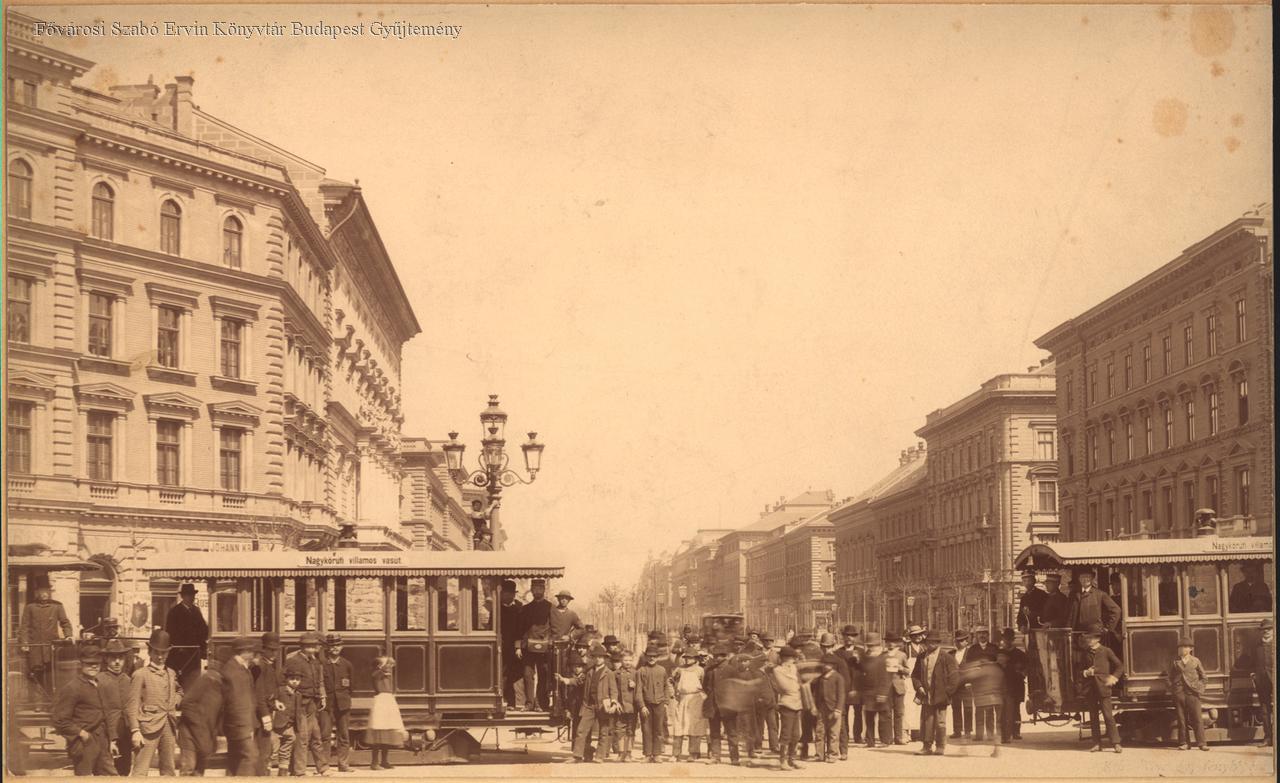 The Oktogon with the trams in 1887, photo by György Klösz (Photo: FSZEK Budapest Collection)
The Oktogon with the trams in 1887, photo by György Klösz (Photo: FSZEK Budapest Collection)
The Outer Ring Road is not uniform, as it consists of several parts, Szent István, Teréz, Erzsébet, József and Ferenc Boulevard. This is also reflected in the fact that the numbering of the houses is not continuous, and the even and odd sides alternate. The reason for this is that in Budapest the numbering starts from the given street's nearest end to Clark Ádám Square.
The Outer Ring Road, 4141 metres long and 45 metres wide in its total length, has been continuously developed for the last 125, but rather 150 years, and even 10 years after the official handover, new buildings have been erected along the road. To build it, 251 buildings had to be demolished, but 253 new ones were built. In fact, it was completed in 1937 with the handover of the Miklós Horthy (now Petőfi) Bridge, as the southern bridge was designed from the beginning and was part of the ideas. The legendary buildings of the boulevard survived revolutions, wars, turned a hotel into an office building like the Royal Hotel in the 1950s, but also turned office buildings into hotels, as we saw in the example of the New York Palace. Although the boulevard is constantly changing, for example, there was a cinema at every tram stop, the Outer Ring Road is a permanent, defining main road in Budapest.
Cover photo: The Outer Ring Road in 1896, at its official opening (Photo: Fortepan/Budapest Archives, No.: HU.BFL.XV.19.d.1.08.032)

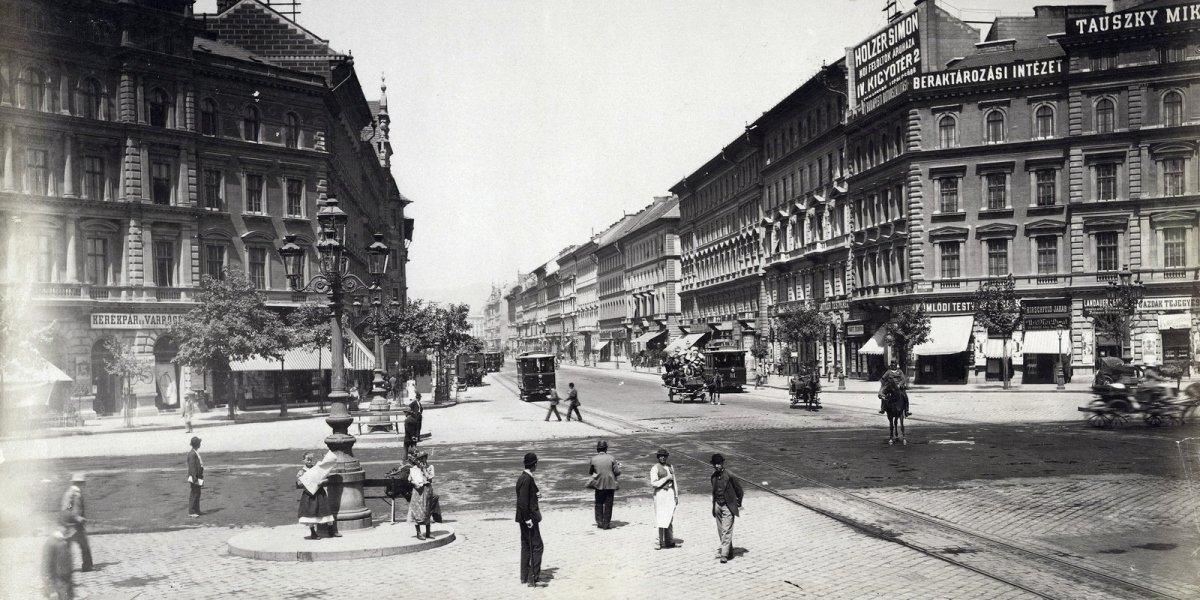


































Hozzászólások
Log in or register to comment!
Login Registration